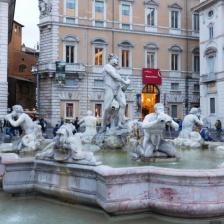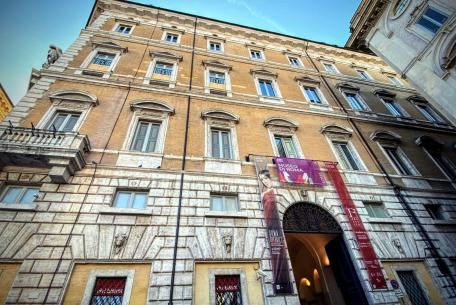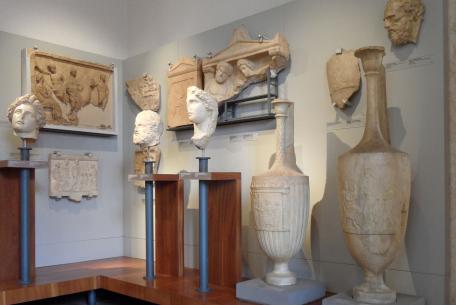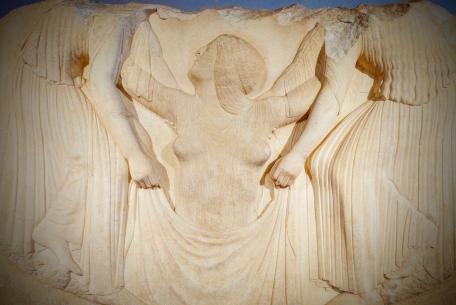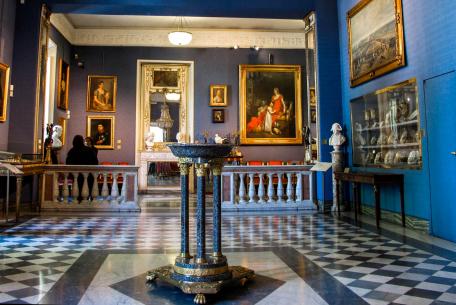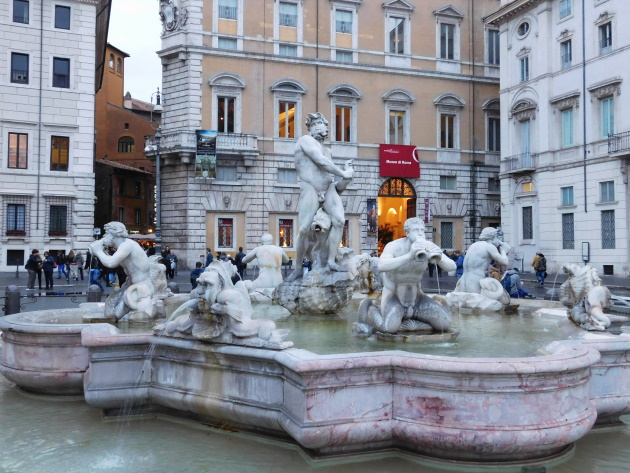
Piazza Navona, considered the most beautiful baroque square in Rome, is located in the heart of the historic center and is among the favorite meeting places for Romans and tourists, thanks to the lively and welcoming atmosphere that characterizes it.
Sitting at one of its trendy cafes for a chat with friends while sipping a drink, eating in one of its elegant outdoor restaurants to enjoy the many culinary specialties that the city offers, strolling through the streets and neighboring alleys in search of romantic or unusual glimpses, are among the experiences to do at least once in a lifetime.
But Piazza Navona and the streets that surround it are more than that. The undisputed charm of this area also lies in the high concentration of artistic masterpieces that can be appreciated here.
You can stroll among unique works of art such as those by Bernini and Borromini, admire the ancient palaces witnessing the splendor of the papal Rome, enter a small church and then find it a real treasure chest, or visit some of the most surprising and fascinating cultural institutions.
We propose you an itinerary to discover the most representative and prestigious museums in Piazza Navona and its surroundings.
Museo di Roma – Palazzo Braschi
Nestled between the interior of the square and Corso Vittorio Emanuele II, you find the 18th-century Palazzo Braschi, which, since 1952, has been the seat of the Museum of Rome.
The scenographic courtyard of this majestic building is only the prelude to a symphony of marvelous rooms, decorated with tempera paintings and refined stuccos.
The Museum of Rome houses numerous paintings and sculptures by Italian and foreign authors active in Rome between the 17th and 20th centuries.
Among the large 17th-century paintings, which depict festive occasions and significant historical events, the one by Andrea Sacchi and Filippo Gagliardi stands out. It portrays the grand show during the Carnival of 1656 at Palazzo Barberini in honor of Cristina of Sweden, who arrived in Rome with great pomp.
In total, the Museum preserves more than 100,000 works including portraits of nobles, popes, and prelates, images of churches, basilicas, squares, palaces, ruins, and landscapes, views of Rome and its surroundings by Italian and foreign authors, 17th-century sculptural works depicting prelates and Roman nobles, and the terracotta sketches by Gian Lorenzo Bernini.
The collection, of which some pieces are exhibited in rotation, is completed by drawings, engravings, photographs, furniture, clothes, ceramics, carriages and sedan chairs, architectural elements, and frescoes.
Thanks to the latest internal renovation of the Museum, you can freely enjoy the museum spaces. There is no obligatory path to follow, but complete freedom of choice that makes you the protagonist and architect of your own visiting experience.
Furthermore, from the windows of the Palazzo, you can enjoy a spectacular view of Piazza Navona.
Museo di Scultura Antica Giovanni Barracco
Just cross Corso Vittorio Emanuele II to find yourself in front of the splendid building housing the Museo di Scultura Antica Giovanni Barracco.
Baron Barracco dedicated most of his life to the gathering of significant works from all over the world. His collection, which counts over 200 including ancient sculptures of Assyrian, Egyptian, Cypriot, Phoenician, Etruscan, and Greco-Roman art, was donated by him to the Municipality of Rome, in 1904.
This prestigious assortment of works of art required an equally prestigious venue. The choice fell on an elegant 16th-century building whose project was attributed to Antonio da Sangallo the Younger: Palazzetto Le Roy, also known as Farnesina ai Baullari or Piccola Farnesina.
The French lilies on its facade gave rise to a misunderstanding: it was believed, in fact, that the palace belonged to the Farnese family, as the lilies are in their coat of arms. Hence, the mistaken title of Farnesina ai Baullari.
Among the most interesting pieces of the collection are examples of Cypriot art, an element of mediation between the Eastern and Greek world. Figures of divinity, images of offerers, and even a small toy cart found in a tomb, represent a unique sample of the art of Cyprus amidst Roman museums.
Museo Nazionale Romano - Palazzo Altemps
On the opposite side of Piazza Navona, on Piazza Sant’Apollinare, you can find Palazzo Altemps, which, together with Palazzo Massimo alle Terme, Crypta Balbi, and the Baths of Diocletian, is part of the National Roman Museum.
Established in 1889, to house the antiquities of Rome, the National Roman Museum as a whole preserves the most important archaeological collection in the world.
The Palazzo Altemps Museum is located in the 15th-century palace built by Girolamo Riario. In 1568, it passed to the Altemps family, who lived there until the mid-19th century. The property was then transferred to Giulio Hardouin, father of the Duchessina Maria, who, in 1883, married Gabriele D’Annunzio. In 1997, after the acquisition by the Italian State and a long and rigorous restoration, the Museum opened to the public.
Inside the museum, you can admire the unique masterpieces of ancient sculpture belonging to famous and prestigious aristocratic collections. The setting integrates the marbles to perfection with the decorative context of the rooms, to re-propose the solutions adopted in the arrangement of the antiquarian collections. The visit path, on two floors, is divided into a series of decorated rooms, an intrigue of stairs, and corridors.
They range from the collections of statues and reliefs from the Altemps, Boncompagni Ludovisi, Mattei, Del Drago collections, to the Jandolo, Veneziani, Brancaccio sculptures, to the Egyptian collection, to the famous Pallavicini Rospigliosi frescoes, to exceptional finds from the antique market, up to the invaluable Evan Gorga archaeological collection, to the 16th and 17th-century collections.
Of particular value, the Boncompagni Ludovisi collection included about 450 sculptures that decorated the avenues and gardens of the Villa of the same name. In the late 19th century, the villa was destroyed for the creation of the Ludovisi district. Part of the collection was dispersed. The Italian state managed to acquire 104 of them. Among these, you can admire the suicidal Galata, Oreste and Elettra, Ares, the Juno Head, and the famous 5th century BC Greek original, the so-called Ludovisi Throne.
Museo Napoleonico
Finally, a few steps from the Palazzo Altemps Museum, on Piazza Ponte Umberto I, is the Napoleonic Museum.
In 1927, Count Giuseppe Primoli, son of Pietro Primoli and Princess Carlotta Bonaparte, and therefore a cousin of Napoleon III, donated to the city of Rome his collection of works of art which included Napoleonic memorabilia and family memories.
The abundant variety of materials allows you to totally immerse yourself in the atmosphere of the Napoleonic era and to meet all the characters who animated it. The historical events of the Bonaparte family are housed in Palazzo Primoli, still conserving its features as a noble home.
The museum's collection testifies to the various aspects of the Emperor's private life, his passions, and his weaknesses, retracing the family history not only with official portraiture but also through the private one that tells of parties, weddings, and baptisms.
The collection was born from the desire to tell the story of the family from a private perspective and to document their intense relationship with Rome.
It, therefore, includes portraits and busts of the exponents of the family, valuable artistic snuffboxes and everyday objects, finely decorated porcelain and albums of memories, jewels, and small wax portraits, books, and clothes.
All are presented in three different sections: the Napoleonic period, testified by large canvases and busts of the major artists of the time who portrayed the exponents of the family in traditional poses; the so-called Roman period, from the fall of Napoleon to the rise of Napoleon III; the Second Empire period, with works referable to the French era dominated by Napoleon III.
 Condividi
Condividi












































